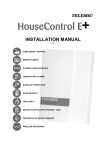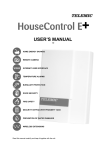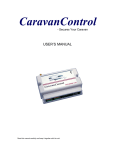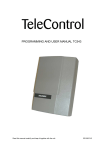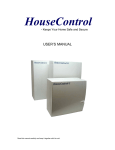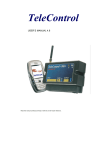Download USER'S MANUAL
Transcript
USER’S MANUAL 1.0 Read this manual carefully and keep it together with the unit. Contents 1. INTRODUCTION .............................................................................................................................................. 3 1.1 FIRST STEPS ............................................................................................................................................. 4 1.1.1 Deciding on the GSM Subscription ............................................................................................... 4 1.1.2 Switching PIN Code Prompt Off from the SIM Card ..................................................................... 4 1.1.3 Installing SIM Card in CaravanControl .......................................................................................... 5 1.1.4 First Text Message ........................................................................................................................ 5 1.2 OPERATING MODES AND OTHER BASIC CONCEPTS...................................................................................... 5 1.2.1 Asking Information from the Unit (Report)..................................................................................... 6 1.2.2 Normal and Disable Operating Modes .......................................................................................... 6 Changing Operating Mode by Phone Call ............................................................................... 6 Changing Operating Mode by Text Message .......................................................................... 7 Signal Light............................................................................................................................... 7 1.2.3 Sending Commands to CaravanControl........................................................................................ 8 1.2.4 Receiving Alarms from CaravanControl ........................................................................................ 8 2. FEATURES..................................................................................................................................................... 10 2.1 REMOTE CONTROL .................................................................................................................................. 10 2.1.1 Heating......................................................................................................................................... 10 Electrical Heating ................................................................................................................... 11 Thermostatic Control.............................................................................................................. 11 Gas Heating ........................................................................................................................... 11 Controlling Heating Manually ................................................................................................. 12 2.1.2 Air-conditioning (or Outdoor Light) .............................................................................................. 12 2.1.3 Refrigerator .................................................................................................................................. 12 2.2 ALARMS .................................................................................................................................................. 13 2.2.1 Fire Alarm..................................................................................................................................... 14 2.2.2 Burglar Alarm ............................................................................................................................... 14 Monitoring the Front Tent....................................................................................................... 14 2.2.3 Gas Alarm .................................................................................................................................... 16 2.2.4 Location Alarm ............................................................................................................................. 16 2.2.5 Restart Notification....................................................................................................................... 16 2.2.6 Power Failure Alarm .................................................................................................................... 17 2.2.7 Low Battery Alarm........................................................................................................................ 17 2.2.8 Cover Open Warning ................................................................................................................... 17 2.2.9 Temperature Alarm ...................................................................................................................... 17 2.3 USER COMMAND SUMMARY ..................................................................................................................... 18 3. SETTINGS ...................................................................................................................................................... 19 3.1 PROGRAMMING MODE ............................................................................................................................. 19 3.2 POWER SAVE MODE ................................................................................................................................ 19 3.3 ASKING SETTINGS ................................................................................................................................... 19 3.4 CHANGING LANGUAGE ............................................................................................................................. 20 3.5 NAMING THE UNIT.................................................................................................................................... 20 3.6 PHONE DIRECTORY ................................................................................................................................. 21 3.7 ALARMS .................................................................................................................................................. 22 3.7.1 Receiving Alarm Messages ......................................................................................................... 22 Alarm Phone Call ................................................................................................................... 22 Answering Machines and Services........................................................................................ 23 3.7.2 Scheduled Report ........................................................................................................................ 23 3.8 TEMPERATURE ALARM LIMITS................................................................................................................... 23 3.9 ACTIVATING REMOTE CONTROL IN ALDE 3010......................................................................................... 24 3.10 USING REMOTE CONTROL IN ALDE 3010................................................................................................. 25 4. TROUBLE SHOOTING .................................................................................................................................. 26 5. TECHNICAL SPECIFICATIONS.................................................................................................................... 28 6. INDEX ............................................................................................................................................................. 29 Document version: CC2_Users_Manual_5_2_en_300.doc 3 INTRODUCTION 1. INTRODUCTION We are very pleased that you chose CaravanControl for keeping your motor caravan or caravan safe and secure. Not only does CaravanControl protect your property, but it also makes the use of your caravan so much more comfortable and fun. This manual describes in detail all the features and commands needed in controlling and monitoring your caravan remotely from your mobile phone. The CaravanControl Quick Guide delivered with the unit serves as a good summary and as a quick cheat sheet for what will be discussed here. CaravanControl makes the use of your caravan comfortable in many ways. For example, you can control heating and air-conditioning remotely by using text messages stored in your mobile phone’s memory. You do not need to memorize any commands yourself. CaravanControl responds to a command by reporting the received command back to you, which can be taken as verification that the command was received and run normally. CaravanControl secures and protects your property by monitoring it and alarming you instantly if something goes wrong. CaravanControl sends a text message and makes an alarm phone call to selected phone numbers if your caravan is stolen, broken into, its inside temperature drops too low, fire breaks loose, electricity is cut off, or liquid gas is detected in the air. In addition to text messages and phone calls, alarm siren will also go on in the case of an alarm. Phone call or text message This manual uses the terms CaravanControl and unit in place of the more complete name of the product: Telemic CaravanControl Remote Controlling and Monitoring Unit. In pictures where interaction is depicted, balloons drawn with dotted lines represent text messages and balloons drawn with solid lines represent phone calls. Contents and index pages can and should be used to aid quick searches of information. Not all equipment discussed in this manual is included in the basic package of CaravanControl. These accessories are optional and can be purchased for additional cost. The basic package contents and additional equipment are shown in the table below. Table 1. CaravanControl basic package and additional equipment. Basic package Additional equipment Indoor motion sensor Smoke detector Indoor temperature sensor Motion sensor for the front tent Outdoor temperature sensor Door magnet Cables for controlling Alde heater Gas sensor Installation material (screws etc.) GPS receiver Siren Outdoor light External antenna Temperature sensor T3 4 CaravanControl User’s Manual Version 5.2 1.1 First Steps CaravanControl needs a valid GSM subscription in order to send text messages and make phone calls. However, before you can insert the SIM card provided by your telecommunications operator into your CaravanControl, you have to switch off the PIN code prompt from the card by inserting the card into your mobile phone and disabling it from your phone’s setup menu. After disabling the PIN code prompt, you can place the SIM card in CaravanControl and close its cover. You should make sure the subscription is operable by making a test phone call to CaravanControl right after the SIM card was installed. CaravanControl must be switched off before installing the SIM card. You will hear three beeps when CaravanControl answers your call. Then it is time to tell CaravanControl your language. You can do this by sending a language setup command (see 1.1.4) to CaravanControl. Upon receiving the command, CaravanControl adds your phone number to its internal phone directory (marks you as a legal user of the unit) and selects language for user commands and alarm messages. CaravanControl reports the settings back to you in a response message from where you can verify that everything went as expected. After you have completed these first steps, the unit will be in disable mode and ready for use. First steps: 1. 1.1.1 Buying a GSM subscription from a telecommunications operator (see 1.1.1). 2. Switching the PIN code prompt off from the SIM card by placing the card into your own mobile phone and navigating to setup menu (see 1.1.2). 3. Installing the SIM card in CaravanControl and making a test call (see 1.1.3). 4. Sending language selection to CaravanControl in a text message and verifying the settings from response message (see 1.1.4). Deciding on the GSM Subscription You can use any GSM subscription available in the market today in your CaravanControl. The expenses of GSM traffic are relatively low, which means that the most economical use is achieved by using a GSM subscription that has a low monthly fee. If you decide to use a prepaid subscription, you should check its balance periodically so that it will not stop working when you least expect it. This is the reason why the use of prepaid subscriptions in CaravanControl is discouraged. ) You should use an unlisted number in your CaravanControl. This ensures that the phone number is not accessible to anyone. However, you should make sure that your CaravanControl can send its own phone number to you alongside an alarm phone call. Otherwise you will not be able to identify the caller as your CaravanControl. 1.1.2 Switching PIN Code Prompt Off from the SIM Card The PIN code prompt must be switched off from the SIM card before it can be used in CaravanControl. You can switch it off from your SIM card by placing the card in your mobile phone and then disabling the prompt from setup menu. Consult the instructions of your mobile phone for how to accomplish this. The PIN code prompt is enabled in all new SIM cards by default. 5 INTRODUCTION 1.1.3 Installing SIM Card in CaravanControl After you have switched off the PIN code prompt; make sure the power is switched off from CaravanControl (power switch = OFF, see picture below). Now you can place the SIM card on the sliding holder inside the unit. You can eject the SIM card holder by pressing the small yellow button gently. Place the SIM card on the sliding holder carefully and make sure the contact side is up and the card is seated correctly on the holder. Push the sliding SIM card holder in and switch power on. It takes about 20 seconds for CaravanControl to start-up. Power switch Sliding SIM card holder ON OFF Press the yellow button gently Picture 1. The sliding SIM card holder is located at the bottom right corner of the central unit. After the SIM card is installed, wait for 20 seconds until CaravanControl goes into programming mode. You recognize this from the signal light that should be blinking rapidly. If this is not the case, make sure the PIN code prompt is indeed disabled, the GSM subscription is operable, the GSM signal strength is sufficient in the area, and that the SIM card was placed properly on the holder. 1.1.4 First Text Message Before you can start using CaravanControl, you must let it know what language you will be using in text messages. You can do this by sending text message LANG xx to the unit (xx being your language choice, see 3.4). This message initializes the unit, adds your phone number in its internal phone directory, and selects language for user commands and alarm messages. You can change the language setting afterwards if you want to use some other language (see 3.4). LANG EN LANG EN (Language: EN = English) P1 +35844nnnn (Your phone number in directory memory cell one) Phone call Text message If you received the return message from CaravanControl as expected, the unit is now in disable mode and ready for use. It is important to realize that now your CaravanControl can be accessed only from your phone number unless it is switched to programming mode (see 3.1). This prevents mischievous users from meddling with the unit’s settings. However, you can add more phone numbers to the phone directory later on for your family members by using text messages (see 3.6). 1.2 Operating Modes and Other Basic Concepts Some of the basic concepts that you will run into in the course of reading this manual are normal and disable modes of operation, remote controlling, and alarms. Understanding these concepts is vital in the path to becoming an efficient and successful CaravanControl user. 6 1.2.1 CaravanControl User’s Manual Version 5.2 Asking Information from the Unit (Report) You can find out the current operating mode (is monitoring on or off?), battery voltage, temperatures, GSM signal strength, and active alarms by sending command ? to the unit. ? TELEMIC CC ALARM: ON TENT: ON (Is monitoring on or off?) (Is the front tent included in the monitored area?) BATT: 13.0 (Battery voltage) IN: +23.1 (Indoor temperature) OUT: -11.2 (Outdoor temperature) GSM: 19 (GSM signal strength 0-31) N63.07600 E27.66000 (Location information, optional) ALARMS: Burglar alarm (Active alarms at the time of the question) http://maps.google.com The above report can also be scheduled for automatic sending (see 3.7.2). The report is printed in the user’s own language. 1.2.2 Normal and Disable Operating Modes There are two operating modes in CaravanControl: normal and disable modes. When the unit is said to be in normal mode, all monitoring is on, whereas in disable mode, monitoring is off except for the 24h monitored sensors (see Table 4). 24h monitoring means that some alarms are processed regardless of the current operating mode. CaravanControl can monitor the front tent of your caravan. Use a text message or switch on the unit for including the tent in the monitored area (see 2.2.2). You can switch from one operating mode to the other by making a phone call or sending a text message command to CaravanControl. It is recommended that you use a phone call for changing the operating mode because it is faster and more convenient than sending a text message even if the command were to be stored in the memory of your mobile phone. , Although operating mode can be changed by two different means, it is recommended that only one method is used to avoid confusion about the current operating mode. There is one more operating mode yet to be discussed here, although it is much less frequently used than the two modes learnt so far, and that is the programming mode. You can switch programming mode on only by opening the unit’s cover (see 3.1). One occasion when you need to set CaravanControl in programming mode is if you want to change the unit’s settings from a phone number that does not exist in the unit’s phone directory. Changing Operating Mode by Phone Call To switch monitoring on or off, make a phone call to your CaravanControl. You will hear one or two beeps that let you know in what mode CaravanControl will be switched to when you close the phone. The sequence is repeated over and over again; therefore, you need to close the phone immediately after you hear the desired number of beeps. One beep means that monitoring is about to be switched on (normal mode) and a series of two beeps means that monitoring is about to be switched off (disable 7 INTRODUCTION mode). This behaviour is similar to the logic used in electric locks in modern cars. A car’s turn indicators flash once when the locks are closed and twice when the locks are opened. Phone call to CaravanControl “BEEP - BEEP” or “BEEP” Phone call Text message Changing Operating Mode by Text Message Alternatively you can switch monitoring on and off with commands ALARM ON and ALARM OFF respectively. You will receive a short report indicating the current operating mode (is monitoring on or off?) and other important information. ALARM ON TELEMIC CC ALARM: ON TENT: ON (Is monitoring on or off?) (Is the front tent included in the monitored area?) BATT: 13.0 (Battery voltage) IN: +23.1 (Indoor temperature) OUT: -11.2 (Outdoor temperature) GSM: 19 (GSM signal strength 0-31) N63.07600 E27.66000 (Location information, optional) ALARMS: Burglar alarm (Active alarms at the moment) Signal Light Table 2. There is a signal light on CaravanControl that tells a lot about the status of the unit. Light Status of the unit One short blink The unit is in normal mode of operation (monitoring is on). Switch to normal mode when you leave your caravan unattended. Two short blinks The unit is in disable mode (monitoring is off, excluding 24h monitored sensors, see Table 4). Set this mode on when there are people in your caravan. One long blink Front tent is included in the monitored area (see 2.2.2). The outdoor motion sensor and door magnets are now monitored 24h even in disable mode. Set this mode on for night to protect people sleeping in the caravan. Blinks rapidly The unit is in programming mode (see 3.1). Anyone can alter the unit’s settings in programming mode. Light is on (no blinking) Error: SIM card is placed improperly, the subscription is not operable, GSM signal strength is too weak, or the PIN code prompt is not switched off from the SIM card. 8 1.2.3 CaravanControl User’s Manual Version 5.2 Sending Commands to CaravanControl Your caravan can be controlled and monitored only from those phone numbers that are listed in the unit’s phone directory. You can add and remove phone numbers from the directory yourself (see 3.6). This guarantees that no one can access your CaravanControl without your approval. You will find often used user commands from this manual (see 2.3) or you can ask list of basic commands directly from your CaravanControl by sending any text message that is not recognized as a valid command. The list of basic commands is returned if the unit receives a command it does not understand. If this happens to you, go over the command once more and make sure there are no typing errors. Text message COMMANDS returns all commands. For example, if you want to turn heating on in your caravan, send command HEATER ON to the CaravanControl. You will receive the same command in response if the heater was switched on successfully. HEATER ON HEATER ON You can save the most often used commands in your mobile phone’s memory for easy access later on. Most mobile phones prompt you to save text messages after typing them. You will find saved messages from “My messages” or “Archive” folder as far as Nokia mobile phones are concerned. 1.2.4 Receiving Alarms from CaravanControl You will receive a text message if something goes wrong or something potentially threatening happens in your caravan. The most important alarms that require immediate and urgent attention are sent to the first five phone numbers in the unit’s phone directory to minimize the possibility that the alarm might not be noticed at all. Less acute alarms are only sent to the phone number in directory memory cell one. The most important alarms are emphasised by an alarm phone call, which draws the user’s attention to the received text message. CaravanControl resets the alarm automatically after 24 hours. If you want to stay inside the caravan, you can reset the alarm by sending command ALARM OFF to your CaravanControl. If you want to reset the alarm and keep monitoring on, you can use command ALARM ON. You will find the settings for each alarm from Table 4. Burglar alarm Alarm phone call “BEEP - BEEP - BEEP” ALARM OFF or ALARM ON or 24h Only the most important alarms set the alarm siren on. The siren is silenced automatically after a few minutes. However, you can turn it off from the switch on the CaravanControl or by sending text message ALARM OFF (this also switches the unit into disable mode). However, it should be noted that if the unit was in normal mode at the time of the alarm, CaravanControl will not cancel the sending of text messages. INTRODUCTION 9 The unit’s operating mode influences the way alarms are handled. In disable mode, a text message is sent and an alarm phone call is made only if the sensor is monitored 24 hours a day (see Table 4). In normal mode, all alarms are sent. 10 2. CaravanControl User’s Manual Version 5.2 FEATURES This section delves much deeper into CaravanControl and how it is best used. The CaravanControl Quick Guide delivered with the unit collects the most frequently used features in one easily palatable format. The Quick Guide should be treated as an aid to your memory and not as a replacement for the complete manual you are holding right now. , Do not switch off the battery of your caravan because the unit does not have a battery on its own. CaravanControl uses the battery of your caravan if there is no 230V power supply. 2.1 Remote Control You can control heating, air-conditioning, outdoor light, and refrigerator with simple text message commands. Remote controls of air-conditioning and outdoor light are alternatives to each other. Only one of them is available to you depending on the model of your airconditioner and how CaravanControl was installed in your caravan. You can also test the alarm siren remotely. Command OUTPUTS returns a list of devices that you can control with text messages. The return message also contains information about which devices are on and which are off at the moment. OUTPUTS HEATER ON AIRCON OFF FRIDGE OFF SIREN OFF Table 3. Devices that can be controlled remotely. Device (also called an output) Commands Heater (either electrical or gas heating) HEATER ON and HEATER OFF Air-conditioning (alternatively outdoor light) AIRCON ON and AIRCON OFF (LIGHT ON and LIGHT OFF) Refrigerator FRIDGE ON and FRIDGE OFF Siren SIREN ON and SIREN OFF ) Siren is not included in the basic package of CaravanControl. 2.1.1 Heating You can switch heater on and off yourself or you can leave it to CaravanControl to keep the temperature at a comfortable and steady level by using thermostatic control. Command OUTPUTS will tell you whether the heater is on or off at the moment. To find out the current temperature in your caravan and outdoor temperature, use command TEMP. 11 Features Electrical Heating You can control electrical heating with commands HEATER ON and HEATER OFF. Once CaravanControl has run the command it received successfully, it will respond with an identical text message. HEATER ON HEATER ON Your caravan will now warm up to the temperature selected from the heater’s control unit. In other words, you have to use the heater’s own control unit for turning on the desired settings before you leave your caravan and send commands from your mobile phone. The command HEATER OFF has the same effect as switching the heater off from the heater’s own control unit. Off Backwater thermostat Ext Power Picture 2. Adjust the settings from the heater’s control panel because these settings cannot be changed remotely. Use the settings depicted in the picture if you have Alde 3000 or 3010 when leaving the caravan with intent to control heating remotely. Thermostatic Control Thermostatic control can be used for keeping indoor temperature at a steady level above zero degrees Celsius. You can set the desired temperature with command HEATER nn, where nn is the desired temperature level. You can also use a negative temperature value if you want to allow temperature to drop below zero, for example HEATER -5. HEATER 7 HEATER 7 You still have to set the maximum temperature from the heater’s control unit as explained earlier. The maximum temperature is the upper limit that CaravanControl must comply with. If you have set the maximum temperature to 21 degrees Celsius, CaravanControl can make the temperature rise up to 21 but not higher. , In Alde Compact 3000 system you have to set i = normal mode, which means that the backwater pump is controlled by thermostat. Gas Heating You can control gas heating with the same commands that were used for controlling electrical heating: HEATER ON and HEATER OFF. However, thermostatic control is not recommended to be used with gas heating. 12 CaravanControl User’s Manual Version 5.2 Controlling Heating Manually You can turn heating on even if you do not have a mobile phone at hand by pressing the manual temperature control switch. You might want to do this if GSM network coverage is poor in the area or if you do not happen to have a mobile phone with access permissions to your CaravanControl nearby that could be used for controlling heating. If manual control is on, you cannot control heating from your mobile phone until you switch manual control off from the switch. Manual heating control on and off Picture 3. Switching manual heating control on and off. Red light indicates that the manual heating control is on. 2.1.2 Air-conditioning (or Outdoor Light) You can control air-conditioning with commands AIRCON ON and AIRCON OFF. AIRCON ON AIRCON ON Use command OUTPUTS to find out whether air-conditioning is on or off. You can control outdoor light if your air-conditioner model cannot be controlled remotely. In other words, remote control of outdoor light is an alternative to air-conditioning control. You cannot have them both. You can switch the outdoor light on and off with commands LIGHT ON and LIGHT OFF. LIGHT ON LIGHT ON ) Cables for controlling air-conditioning (light) remotely are not included in the basic package of CaravanControl. 2.1.3 Refrigerator Refrigerator can be controlled with commands FRIDGE ON and FRIDGE OFF. FRIDGE ON FRIDGE ON Command OUTPUTS can be used for asking whether the refrigerator is on or off at the moment. ) Cables for remote control of refrigerator are not included in the basic package. 13 Features 2.2 Alarms CaravanControl monitors and secures your motor caravan or caravan with motion, fire, gas, and temperature sensors. In addition, there are door magnets on the door to protect your property from break-in and entry and a GPS receiver to protect against caravan theft. When one of the aforementioned sensors alarms or some internal abnormality in CaravanControl calls for attention, it makes an alarm phone call and sends detailed information about the cause that lead to the alarm in a concise text message to the users. Outdoor motion sensor Fire alarm right above the door Door magnets Indoor motion sensor Indoor temperature Gas sensor GPS receiver Outdoor temperature sensor in the chassis Picture 4. Recommended sensor locations in a caravan. The following table contains all alarm and notification messages CaravanControl can send. Column “Users” lists the directory memory cells containing the phone numbers where the alarm is sent. Most alarm messages are sent to the first five phone numbers in the directory. Columns “SMS” and “Call” are quite self-explanatory: they indicate whether the alarm is forwarded as a text message or as a phone call or as both. The next column ”▲▼” contains information about whether the alarm is two-way, meaning that a text message is sent (and perhaps a phone call) on both activation and deactivation of the alarm. The three rightmost columns indicate what alarms can be sent in the different modes of the unit. Table 4. Alarms settings (see Table 2 for explanations of the symbols). Alarm or notification Users SMS Call ▲▼ Fire alarm 1-5 ● ● ○ ● ● ● Burglar alarm (motion sensor inside) 1-5 ● ○ ○ ● ○ ○ Burglar alarm tent (motion sensor in tent) Burglar alarm door (door switch) 1-5 ● ○ ○ ● ○ ● 1-5 ● ○ ○ ● ○ ● Gas alarm 1-5 ● ● ○ ● ● ● Location alarm (GPS) 1-5 ● ○ ○ ● ○ ○ Restart notification 1 ● ○ ○ ● ○ ○ Power failure 230V alarm 1 ● ○ ● ● ○ ○ Low battery alarm 1 ● ○ ● ● ● ● Cover open warning/Progr. mode on 1 ● ○ ● ● ● ● Scheduled report 1 ● ○ ○ ● ● ○ Indoor temperature alarm 1 ● ○ ● ● ○ ○ Outdoor temperature information 1 ● ○ ● ● ○ ○ 14 CaravanControl User’s Manual Version 5.2 Alarm messages contain following information: the optional name of the caravan (see 3.5), the reason for the alarm, and some additional information about the alarm if available (e.g. temperature value that triggered the alarm). Some examples of alarm messages (the unit has been named “Caravan”): Caravan Burglar alarm Caravan Power 230V failure Caravan Indoor Temperature alarm IN: +9.4 CaravanControl might send you a text message on deactivation of the alarm as well: Caravan Power 230V OK Caravan Indoor Temperature OK IN: +15.4 2.2.1 Fire Alarm CaravanControl sends a text message and makes a phone call if fire breaks loose in the caravan. Fire alarm turns the siren on, too. Fire alarm “BEEP - BEEP - BEEP” ) Smoke detector is not included in the basic package of CaravanControl. 2.2.2 Burglar Alarm CaravanControl sends you a text message and makes an alarm phone call if it detects movement inside the caravan or in the front tent or if someone opens or breaks the door to your caravan. Burglar alarm turns the local alarm siren on as well. Burglar alarm “BEEP - BEEP - BEEP” If the burglar breaks or opens the cover on CaravanControl, a notification message is sent but siren is kept silent. Burglar alarm is active in the normal mode of the unit, which is why the unit must be switched to disable mode before opening the cover. Otherwise opening the cover will result in a notification message. Monitoring the Front Tent You can include the front tent in the monitored area with command TENT ON and remove it with command TENT OFF. If someone enters the tent while monitoring is on or the monitoring of tent has been switched on from inside the caravan, the siren lets out a couple of short beeps as a warning to the trespasser and the outdoor light is switched on. If the intruder ignores these warning signals and refuses to leave, the siren goes on and CaravanControl sends alarm messages and calls the appropriate phone numbers. To find out whether the tent has been included in the monitored area, ask a report from your CaravanControl. 15 Features TENT ON TENT ON It is recommended that the monitoring of front tent is turned on from the switch on CaravanControl for night. This causes the unit to remain in disable mode allowing you and your family to stay and move around in the caravan while the front tent and the entrance door to your caravan are being monitored and protected against nightly intruders. In other words, the outdoor motion sensor and door magnets are now monitored 24 hours a day, and alarm messages from these sensors are sent regardless of the operating mode. ) Door magnets and motion sensor for the tent are not included in the basic package of CaravanControl. Switch for front tent monitoring Picture 5. Switching front tent monitoring on and off. You should remember to switch off the front tent monitoring before opening the door in the next morning so that no alarm is caused by accident. You can silence the siren and cancel alarm messages from the front tent monitoring switch if the alarm was an accident. Front tent has been assembled Include the tent in the monitored area with command TENT ON You leave the caravan unattended Night falls Switch monitoring on from the button on the bottom of the unit. Switch monitoring on by phone call. The caravan and front tent are now monitored and protected. In the morning You return back to your caravan Switch monitoring off by pressing the button before stepping out of the caravan. Switch monitoring off by phone call before entering the front tent. Still living in the caravan Front tent is disassembled Remove the tent from the monitored area with TENT OFF Picture 6. Recommended usage of operating modes. 16 2.2.3 CaravanControl User’s Manual Version 5.2 Gas Alarm Caravan control makes a gas alarm if it detects liquid gas in the indoor air. Gas alarm “BEEP - BEEP - BEEP” CaravanControl alarms you immediately if it detects gas in the air, giving you plenty of time getting out of the caravan. ) Gas detector is not included in the basic package of CaravanControl. 2.2.4 Location Alarm If your Caravan is furnished with a GPS receiver and the unit is in normal mode of operation (monitoring is on), CaravanControl monitors the location of your caravan and sends you an alarm message if your caravan is stolen. Location alarm N63.07600 E27.66000 SPD 12 TRK 183 UTC 14:22:23 You can set location monitoring on with command LOC nn, where nn is the maximum distance in metres your caravan is allowed to be moved before an alarm is sent. For example, LOC 50 does not allow your caravan to be moved more than 50 metres from its current position. LOC 50 LOC 50 However, you should not set the distance too short because it increases the risk of unnecessary alarm messages due to limited precision. Therefore the minimum value for location alarm is 20. Command LOC OFF sets the location monitoring off and LOC returns the current setting. ) GPS receiver is not included in the basic package of CaravanControl. 2.2.5 Restart Notification CaravanControl sends you a restart notification about half an hour from the moment it was switched on. The notification is sent every time the unit is powered up. 17 Features CaravanControl started 2.2.6 Power Failure Alarm CaravanControl sends you an alarm message in the case of a power failure. The alarm threshold for is 13.2V. Power 230V failure 2.2.7 Low Battery Alarm CaravanControl sends you an alarm message if the battery voltage drops too low. The alarm threshold for is 11.5V Battery voltage low 8.6V 2.2.8 Cover Open Warning CaravanControl sends you a notification when the unit’s cover is opened or closed. Opening the cover causes the unit to enter programming mode which is a security risk because in programming mode all phone numbers can have access your CaravanControl (see 3.1). Cover open: Programming mode on 2.2.9 Temperature Alarm CaravanControl monitors both indoor and outdoor temperatures. Alarm limits can be set for the indoor temperature with a specific setup command (see 3.8). Indoor Temperature alarm IN: +9.4 If you wish to use temperature alarms with thermostatic control, the alarm limits must have margins of at least three degrees Celsius. For example, if you use thermostatic control to keep the temperature at 10 to 21 degrees above zero, the alarm limits should be 7 and 24 degrees respectively. 18 CaravanControl User’s Manual Version 5.2 2.3 User Command Summary You can send only one command in one text message. Commands are case-insensitive, which means that any command can be given either in lower, upper, or mixed-case. Commands heater on, HEATER ON, and Heater On are all acceptable. Table 5. User commands. These commands have localized counterparts in different languages. Command Explanation ? Prints out a report (see 1.2.1) COMMANDS Prints a list of all available user commands OUTPUTS Asks the status of remote controllable devices (see 2.1) ALARM ON Sets the unit in normal mode (monitoring on, see 1.2.2) ALARM OFF Sets the unit in disable mode (monitoring off) ALARM Asks the current operating mode (monitoring on or off?) TENT ON Includes the front tent in monitored area (see 2.2.2) TENT OFF Removes the front tent from the monitored area TENT Asks the status of tent AIRCON ON Starts air-conditioning (see 2.1.2) AIRCON OFF Stops air-conditioning AIRCON Asks the status of air-conditioning FRIDGE ON Switches refrigerator on (see 2.1.3) FRIDGE OFF Switches refrigerator off FRIDGE Asks the status of fridge HEATER ON Switches heating on as selected from the heater’s control panel HEATER OFF Switches heating off HEATER nn Sets temperature to nn (thermostatic control) HEATER Asks the value set to heater TEMP Asks indoor and outdoor temperatures LIGHT ON Switches outdoor light on (see 2.1.2) LIGHT OFF Switches outdoor light off LIGHT Asks the status of light LOC nn Sets location monitoring (nn = distance in metres, see 2.2.4) LOC OFF Switches location monitoring off LOC Asks the setting of location monitoring SIREN ON Sets siren on SIREN OFF Sets siren off SIREN Asks the status of siren 19 SETTINGS 3. SETTINGS So far we have only been discussing how CaravanControl is used everyday, this section, however, deals with the setup of the unit that does not require your attention on a daily basis. That being said, some of the settings that you will most likely have to change at some point are the users’ phone numbers and temperature alarm limits. For example, if you want to add new users or remove old ones from your CaravanControl, you will need to update the unit’s internal phone directory accordingly. Temperature alarm limits may also need adjustment if you want to keep the indoor temperature at a lower lever than what is allowed by default or if you want to stop heating altogether. 3.1 Programming Mode CaravanControl must be switched to programming mode if you intend to change its settings from a phone number not listed in the unit’s phone directory. You can set CaravanControl into programming mode by opening its cover. The signal light will start blinking rapidly when programming mode sets in. A notification message is sent to phone number in directory memory cell one if the cover is opened while monitoring is on. It is paramount to realize that the unit is not protected against mischievous users when it is in programming mode. Anyone with adequate knowledge of CaravanControl can send commands and alter the unit’s settings if he or she knows your CaravanControl’s phone number. This is why programming mode can be switched on only by opening the unit’s cover in the caravan. CaravanControl enters this mode automatically when it is powered up for the first time. CaravanControl can be set back to normal or disable mode in any of the following three ways: by closing the cover, by making a phone call, or by sending a command to CaravanControl (see 1.2.2). Remember that CaravanControl must have your phone number in its phone directory before you can call or send messages to it. 3.2 Power Save Mode You can set your CaravanControl into power save mode with command SLEEP ON. When the unit is in power save mode, it wakes up once in every hour for three minutes to check if there are new alarms. This might be quite workable solution, for example, if you are using your CaravanControl only for temperature alarms where it does not matter if you receive an alarm a little late. To quit power save mode, just give command SLEEP OFF. SLEEP ON SLEEP ON 3.3 Asking Settings You can ask the current value of a particular setting by appending a question mark at the end of the command. For example, command P? gives you a full listing of the phone numbers in the phone directory (see 3.6). CaravanControl will send you more than one text message if not 20 CaravanControl User’s Manual Version 5.2 all information fits into one text message. Note that the order in which the messages arrive in your mobile phone can be changed from the original and intended order in the SMS Service provided by your operator. ) If the unit fails to respond to your text message, check the syntax of the command and make sure that your phone number is stored in the unit’s phone directory correctly. 3.4 Changing Language CaravanControl comes with several different languages. Before you can use your CaravanControl, you must select your language with command LANG xx, where xx is a twoletter language code (not country code). You can find out the current language with command LANG LANG EN LANG EN Table 6. User commands and messages are available as localized versions in the following languages. Command Language LANG EN English LANG FR French LANG ES Spanish LANG DE German LANG SV Swedish LANG NO Norwegian LANG FI Finnish LANG NL Dutch LANG IT Italian LANG PT Portuguese Language selection changes the user commands and alarm messages. , Switching from one language to another clears the entire phone directory and the name of the unit (see 3.5). Users’ phone numbers must be given after language is selected. 3.5 Naming the Unit CaravanControl inserts the name of your motor caravan or caravan at the beginning of all alarm messages. You can name your caravan with command NAME yy, where yy is the name you wish to give. The name can be up to 20 characters long and it can be asked with command NAME. 21 SETTINGS NAME Caravan NAME Caravan The name can be cleared by sending NAME to your CaravanControl (i.e. send the same command without the name part). 3.6 Phone Directory CaravanControl uses phone directory for receiving commands and sending alarm messages to the listed numbers. CaravanControl can store up to 20 phone numbers in the directory. All numbers must be stored in international format (beginning with +44 in the U.K.) because otherwise they will not work because text messages always use international format in phone numbers. , Directory memory cell 0 is reserved for the GSM operator’s SMS Service number. Normally you do not have to set the SMS Service number, but if your CaravanControl does not send any text messages, you might need to program it manually to memory cell 0. The unit sends alarm messages to the phone numbers in memory cells 1 through 5. Commands and questions messages can be sent from the phone numbers in memory cells 6 through 20, however, no alarm messages are sent to these numbers. If you want to change the unit’s settings from a phone number not listed in the directory, you must set the unit in programming mode (see 3.1). A new phone number can be added to the directory with command Px nnnnnnn, where x is the directory memory cell number (1-20, or 0 for the SMS Service number) and nnnnnnn is the user’s phone number in international format It is a good practice to check the contents of the directory before making any changes to it so that no phone numbers are overwritten accidentally. In the following example, a new user is being added in directory memory cell two. P? P0 P1 +441234567 P2 P3 … P20 P2 +447654321 P2 +447654321 Use the following commands for editing phone numbers: Adding a new phone number in the directory P x n n n n n n n 22 CaravanControl User’s Manual Version 5.2 Sets the phone number nnnnnnn in memory cell x (1 - 20). x = 0 for the SMS Service number (normally not needed). The phone number must be in international format. Asking phone numbers P ? Prints the entire phone directory. Asking a single phone number P x ? Prints the phone number in memory cell x. x = Memory cell number 0 through 20. Removing a phone number from the directory P x Clears the phone number in memory cell x. x = Cell number 0 - 20. 3.7 Alarms By default, alarm messages are sent only to the first five phone numbers in the phone directory. If you want to add a new user in CaravanControl with the ability to receive alarms, set his or her phone number in one of these memory cells. In some cases the alarm is sent only to the phone number in directory memory cell one (see Table 4). 3.7.1 Receiving Alarm Messages CaravanControl sends alarm information in a text message, but in some cases it also makes a phone call to emphasize the importance of the alarm. What this means is that CaravanControl makes a phone call to each and every phone number in directory memory cells 1 through 5 in addition to text messages. The alarm is acknowledged by picking up the phone. CaravanControl will keep on calling until someone answers or until the alarm expires in two hours. Burglar alarm “BEEP - BEEP - BEEP” Alarm Phone Call If phone calls (see Table 4) are used, CaravanControl keeps on calling relentlessly until someone picks up the phone. CaravanControl considers it as an acknowledgement when the phone call is answered by your answering machine. Notification messages from operators (such as “The number you are trying to call cannot be reached…”) are not regarded as acknowledgements (see “Answering Machines and Services”). ) CaravanControl keeps on calling to the specified number even if it is not a valid or a correct phone number. CaravanControl also keeps on calling to mobile phones until someone answers even if their mobile phones are out of reach of the GSM network, and 23 SETTINGS this might result in some delays in the operation of the unit. Alarms expire in two hours by default, and this is when CaravanControl gives up and quits calling at the latest. Answering Machines and Services CaravanControl waits for your answer for 20 seconds. If you have an answering service enabled in your GSM subscription, you have to make sure the alarm phone call does not go to the answering machine in those 20 seconds so that no alarms get acknowledged by the service. This is a potentially dangerous scenario and should be considered carefully when using answering machines and services as you might not check the received message soon enough. When you pick up the phone, CaravanControl sends two signals to alert you that connection has been established. 3.7.2 Scheduled Report CaravanControl can be programmed for sending a report at certain intervals. To schedule a report, use command REPORT d, where d is the interval in days (some examples: 0 = never, 1 = daily, 2 = every other day, 7 = weekly). The report is send weekly by default, and maximum value is 30, which is about once a month. The scheduled report is the same report that can be asked with command ? (see 1.2.1). REPORT 7 REPORT 7 The first report is sent immediately after running the command and the next as soon as the specified number of days has elapsed. You can ask this setting with command REPORT. 3.8 Temperature Alarm Limits There are temperature sensors for measuring indoor and outdoor temperatures in CaravanControl. They have a fixed hysteresis of two degrees which effectively prevents redundant alarm messages from being sent when the temperature fluctuates around the set alarm limit. What this means is that if the lower temperature alarm limit is set to +10 degrees Celsius, the temperature must climb at least up to +12 before new temperature alarms are at all possible. Table 7. Sensors measuring temperature. Sensor Location T1 Inside the motor caravan or caravan T2 Outside (in the chassis of the caravan) T3 Optional ) Temperature sensor T3 is not included in the basic package of CaravanControl. You can ask the current temperatures and alarm limits with command T?. Asking temperatures and limits T ? 24 CaravanControl User’s Manual Version 5.2 An example response message for T? -command: T1 +10 +45 IN T2 -50 +50 OUT T3 -50 +50 FREE (Optional) The first value is the sensor id (See Table 7), the following two values are the lower and upper alarm limits (i.e. the acceptable temperature range) and the last one is the name of the sensor. Settings alarm limits and name for the indoor temperature sensor T 1 x y n n n x = Lower alarm limit y = Upper alarm limit nnn = Name of the sensor An example alarm limit and naming command: T1 10 45 IN An example response message for alarm limit and naming command: T1 +14 +45 IN The alarm limit values must be given in whole numbers or with one decimal if need be. Negative values can be used as well. Temperature alarm is sent immediately when the indoor temperature rises above or drops below the set limits. ) You can set the alarm limits and name for the outdoor and optional sensor in the same manner, just remember to use T2 when referring to the outdoor sensor and T3 when referring to the optional temperature sensor. 3.9 Activating Remote Control in ALDE 3010 In ALDE 3010, you must first activate remote control before it is possible to control your caravan’s heating with text messages. Go through the following steps: If no menu is displayed, do the following: 1. 2. Press the right arrow until the mark in the bottom left corner starts blinking. Activate the menu row by pressing the +/On button. Picture 7. Activating menu row. 1. 2. Picture 8. Activating remote control. Press the right arrow until Ext starts blinking. Now you can see whether remote control is activated or not ON/OFF. Activate remote control by pressing the +/On button. The text should read now ON. 25 SETTINGS 3.10 Using Remote Control in ALDE 3010 You have two different ways for controlling ALDE 3010 heater. You can either use HEATER ON / HEATER OFF commands or thermostatic control with command HEATER nn. When using ON/OFF commands, you send HEATER OFF command to ALDE 3010 and switch the heating system off when leaving the caravan. When using thermostatic control, you set the desired temperature level with command HEATER nn. Note: the heater might be on for one or two minutes after sending the command. 1. 2. Send HEATER OFF command or set the temperature, for example, to 7 degrees with HEATER 7. Press the right arrow until On starts blinking. Press the -/Off button. Press the left arrow until the control panel goes into a position of rest. Now remote control is in use. 2. 3. 4. 5. 4. Picture 9. Using remote control in Alde 3010. 5. 26 4. CaravanControl User’s Manual Version 5.2 TROUBLE SHOOTING If your CaravanControl fails to function properly, please go through the steps in the table below. Problem description: What to check Indicator light is off: Switch power on and wait for 20 seconds. Check the fuse on the power cord. Correct operation The light blinks. The light blinks. Verify that the unit’s own power switch is in position The light blinks. ON. The signal light is on (does not blink) and call does not get connected to the unit: Check whether the PIN code prompt is on. Disable The call gets connected. the prompt from the SIM card by using your own mobile phone. Make sure the GSM subscription is opened and test it The call gets connected. in your mobile phone. Make sure the SIM card is seated correctly on the sliding SIM card holder. The call gets connected. Check GSM signal strength in the area. Move to area with adequate coverage. The call gets connected. Check your CaravanControl’s GSM number. The call gets connected. The device answers with three beeps and closes the line, but operating mode does not change: Make sure the caller’s phone number is in the unit’s CaravanControl answers with one phone directory. Exit programming mode. (normal mode) or two beeps (disable mode). The device closes the call immediately without an answer: Make sure the caller’s phone number is in the unit’s CaravanControl answers with one phone directory. (normal mode) or two beeps (disable mode). CaravanControl receives commands but does not reply to them: Set the unit in programming mode and add the user’s CaravanControl responds with a text phone number in the phone directory. message. SMS Service number might be missing from the SIM CaravanControl responds with a text card. Insert your operator’s SMS service number in message. the phone directory memory cell 0. The maximum number of text messages per day CaravanControl responds with a text TROUBLE SHOOTING might have been consumed. 27 message. The SIM card might have a limit for how many messages can be sent. Your mobile phone’s SMS memory could be full. CaravanControl does not send alarm messages: Check if the alarm is sent in normal mode only. Alarm message is sent. Switch monitoring on if alarm is sent only in normal mode. Make sure the unit is not in programming mode. Alarm message is sent. Switch it back to normal mode by by sending command ON or by making a phone call to the unit. Add the user’s phone number in the phone directory. Alarm message is sent. CaravanControl makes only a phone call when it should also send a text message: Set your operator’s SMS Service phone number to Alarm message is sent. directory memory cell 0. Your mobile phone does not display CaravanControl’s phone number when it is calling: CaravanControl cannot send its own phone number CaravanControl’s phone number is to you because it is denied in the GSM subscription. displayed when it calls. Alarm is sent every time monitoring is switched on: Check the wires of the alarming sensor. Alarms field is empty in the report (use command ?) No state changes in outputs: Add your number in the phone directory. CaravanControl responds with a text CaravanControl must know your phone number messages. before it can run any commands you send to it. Check the syntax of the command. Heating does not go on: Check the settings on the control panel. State of the output changes. Heater goes on after sending the command. If you have Alde 3010, make sure remote control is Heater goes on after sending the activated. command. Check the syntax of the command, for example, Heater goes on after sending the HEATER ON command. You have run out of liquid gas. Heater goes on after sending the command. Battery voltage has dropped below 11.5V. Heater goes on after sending the command. 28 5. CaravanControl User’s Manual Version 5.2 TECHNICAL SPECIFICATIONS Dimensions: Weight: Current consumption: Supply voltage: Serial port: Maximum values for outputs: Inputs: 146 x 211 x 52 mm ca 420 g unit at idle 1.5 - 20 mA / 12 V Max 100 mA 9 – 14.5 V RJ-8 power 72 W, current 6 A, voltage 12 V min. control circuit current 3,5mA/12V max. control circuit resistance 30kohm / 12V Operating conditions: GSM module: SIM card: Antenna: -30…+70 °C Siemens TC65 small, 3V Quad-band (850/900/1800/1900), SMA connector The unit is not protected against water or any liquids. Note! Even though CaravanControl uses supply voltage of 9-14.5V, please, keep in mind that external devices (such as motion detectors) might not tolerate such high voltages. Technical specifications are subject to change without prior notice. GUARANTEE Telemic guarantees this CaravanControl product for 24 months against material defects and flaws in manufacturing this product starting from the date of purchase. Defects are corrected with replacement parts, by fixing the old elements, or by providing a new equivalent product for the customer. Defects that are caused by natural deterioration over time, overloading, or by any other inappropriate use of this product are outside the sphere of this guarantee. Reclamations can be only accepted if the bought unit is returned to the retailer or to the manufacturer unopened. PROOF OF COMPLIANCE TO STANDARDS The manufacturer guarantees that this product complies with the following standards: EN 55022, EN 61000-3-2, EN 61000-3-3, EN61000-4-2, EN 61000-4-3, EN 61000-4-4, EN 61000-4-5, EN 61000-4-6, Low Voltage Directive 73/23/EEC and the Amendment to LVD 90/683/EEC EMC Directive 89/336/EEC 2004/108/EC Automotive Directive 72/245/EEC and the amendment 2005/83/EC R&TTE Directive 99/5/EC Telemic Oy 29 INDEX 6. INDEX A Alarms .................................................................... 13 Alde 3010.........................................................10, 24 Alde 3010 control panel......................................... 24 Alde Compact 3000 ............................................... 11 Answering machines ............................................. 23 B Battery.................................................................... 10 C Canceling an alarm.................................................. 8 Control circuit current ............................................ 28 Control circuit resistance ....................................... 28 Controlling heating manually ................................. 12 D N Normal mode ........................................................... 6 O Operating modes ..................................................... 6 P Phone directory...................................................... 21 PIN code prompt...................................................... 4 PrePaid subscription................................................ 4 Programming mode ............................................... 19 R Receiving alarms ............................................... 8, 22 Remote control ...................................................... 10 Report ................................................................ 6, 23 Restart notification ................................................. 16 Disable mode ........................................................... 6 S F First steps ................................................................ 4 First text message ................................................... 5 Front tent................................................................ 14 G GPS........................................................................ 16 GSM module .......................................................... 28 H Heating................................................................... 10 Hysteresis .............................................................. 23 Scheduled report ................................................... 23 Sending commands................................................. 8 Sensors.................................................................. 13 Signal light ............................................................... 7 SIM card............................................................. 5, 28 SMS Service number............................................. 21 Supply voltage ....................................................... 28 T Technical specifications......................................... 28 Temperature alarm limits....................................... 23 Thermostatic control .............................................. 11 Trouble shooting .................................................... 26 Typing commands ................................................. 19 L Language ............................................................... 20 Liquid gas............................................................... 16 U Unit name .............................................................. 20 Unlisted number....................................................... 4 User commands..................................................... 18 30 CaravanControl User’s Manual Version 5.2 Isoharjantie 6 Tel. +358 20 7288 740 71800 Siilinjärvi Fax +358 17 462 1212 FINLAND [email protected] http://www.telemic.fi































